
A Century of Progress International Exposition, also known as the Chicago World's Fair, was a World's Fair held in the city of Chicago, Illinois, United States from 1933 to 1934. The fair, registered under the Bureau International des Expositions (BIE), celebrated the city's centennial. The theme of the fair was technological innovation, and its motto was "Science Finds, Industry Applies, Man Adapts", giving out a message that science and American life were wedded. Its architectural symbol was the Sky Ride, a transporter bridge perpendicular to the shore on which one could ride from one side of the fair to the other.

Beverly Shores is a town in Pine Township, Porter County, Indiana, United States, about 36 miles (58 km) east of downtown Chicago. The population was 613 at the 2010 census.
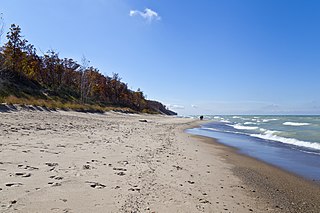
Indiana Dunes National Park is a United States national park located in northwestern Indiana managed by the National Park Service. It was authorized by Congress in 1966 as the Indiana Dunes National Lakeshore and was redesignated as the nation's 61st national park on February 15, 2019. The park runs for about 20 miles (32 km) along the southern shore of Lake Michigan; it covers 15,349 acres (6,212 ha), including the 2,182-acre (883 ha) Indiana Dunes State Park and Hoosier Prairie State Nature Preserve, which are owned and managed by the Indiana Department of Natural Resources. The visitor center is in Porter, Indiana. Located in the park are sand dune, wetland, prairie, river, and forest ecosystems.

Jackson Park is a 551.5 acre (2.2 km²) park located on the South Side of Chicago, Illinois. As part of the Woodlawn community area, it extends along Lake Michigan and borders onto the neighborhoods of Hyde Park and South Shore. It was originally designed in 1871 by Frederick Law Olmsted and Calvert Vaux, then greatly remodeled in 1893 to serve as the site of the World's Columbian Exposition, leaving it as one of the largest and most historically significant parks in the city. A number of features attest to the legacy of the fair, including a Japanese garden, the Statue of TheRepublic, and the Museum of Science and Industry.
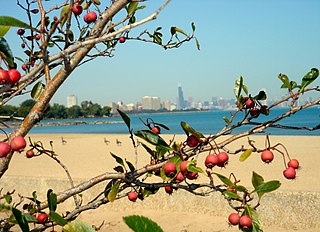
South Shore is one of 77 defined community areas of Chicago, Illinois, United States. A predominantly African-American neighborhood on the city's South Side, the area is named for its location along the city's southern lakefront. Although South Shore has seen a greater than 40% decrease in residents since Chicago's population peaked in the 1950s, the area remains one of the most densely populated neighborhoods on the South Side. The community benefits from its location along the waterfront, its accessibility to Lake Shore Drive, and its proximity to major institutions and attractions such as the University of Chicago, the Museum of Science and Industry, and Jackson Park.

The Near South Side is a community area of Chicago, Illinois, United States, just south of the downtown central business district, the Loop. The Near South Side's boundaries are as follows: North—Roosevelt Road ; South—26th Street; West—Chicago River between Roosevelt and 18th Street, Clark Street between 18th Street and Cermak Road, Federal between Cermak Road and the Stevenson Expressway just south of 25th Street, and Clark Street again between the Stevenson and 26th Street; and East—Lake Michigan.
U.S. Route 12 (US 12) is a part of the United States Numbered Highway System that runs from Aberdeen, Washington, to Detroit, Michigan. In the U.S. state of Indiana, it is part of the state road system. US 12 enters the state concurrent with US 20 and US 41 in Whiting. The 45.16 miles (72.68 km) of US 12 that lie within Indiana serve as a major conduit. Some of the highway is listed on the National Highway System. Various sections are rural two-lane highway, urbanized four-lane undivided highway and one-way streets. The easternmost community along the highway is Michiana Shores at the Michigan state line.
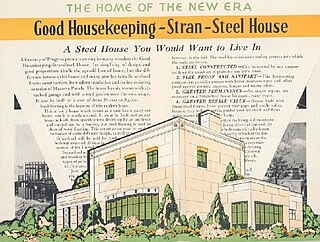
The Homes of Tomorrow Exhibition was part of the 1933 Chicago World's Fair. The Fair's theme that year was a Century of Progress, and celebrated man's innovations in architecture, science, technology and transportation. The "Homes of Tomorrow" exhibition was one of the most noteworthy exhibits of the Fair, and showcased man's modern innovations in architecture, design, and building materials.
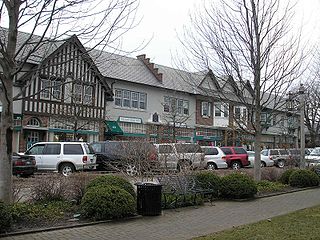
Howard Van Doren Shaw AIA was an architect in Chicago, Illinois. Shaw was a leader in the American Craftsman movement, best exemplified in his 1900 remodel of Second Presbyterian Church in Chicago. He designed Marktown, Clayton Mark's planned worker community in Northwest Indiana.
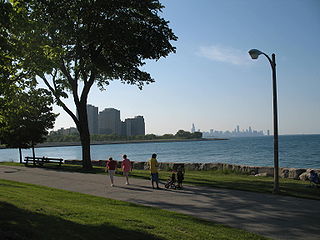
Burnham Park is a public park located in Chicago, Illinois. Situated along 6 miles (9.7 km) of Lake Michigan shoreline, the park connects Grant Park at 14th Street to Jackson Park at 56th Street. The 598 acres (242 ha) of parkland is owned and managed by Chicago Park District. It was named for urban planner and architect Daniel Burnham in 1927. Burnham was one of the designers of the 1893 World's Columbian Exposition.

Beverly Shores is a train station in Beverly Shores, Indiana, served by the South Shore Line interurban commuter railroad. The station serves the town of Beverly Shores as well as the nearby Town of Pines. It is a flag stop.

Miller Beach is a neighborhood of Gary, Indiana on the southernmost shore of Lake Michigan. First settled in 1851, Miller Beach was originally an independent town. However, the "Town of Miller" was eventually annexed by the then flourishing city of Gary in 1918. Located in the northeastern corner of Lake County, Indiana, the former town is now known as "The Miller Beach Community." Miller Beach borders Lake Michigan to the north, Porter County to the east, and is largely surrounded by protected lands, including Indiana Dunes National Park. Miller Beach is also the closest beach/resort community to Chicago, and has been a popular vacation spot since the early 20th century. As of the 2000 US census, it had a population of 9,900.

The Florida Tropical House is a beach house located on Lake Michigan's shoreline in Beverly Shores, Indiana. It was built in 1933 as part of the Homes of Tomorrow Exhibition at the 1933 World's Fair in nearby Chicago. Today it is part of the Century of Progress Architectural District, a historic district.

The Armco-Ferro House, in Beverly Shores, Indiana, was originally constructed for the 1933 Century of Progress Exposition in Chicago. "The ... Exposition opened in May of 1933 directed by the theme of science and its role in industrial advancement. Within the Home and Industrial Arts Group were model houses, which featured modern materials, building methods and innovative home appliances, including the Armco-Ferro-Mayflower, Wieboldt-Rostone and Florida Tropical houses, and the House of Tomorrow. All utilized new techniques of design, construction and prefabrication in an attempt to bring the out-of-date housing industry in line with more efficient manufacturing practices such as those used by the auto industry." The Home and Industrial Arts Group was the most successful venue of the Exposition. The Armco-Ferro House was designed by Robert Smith, Jr., of Cleveland, Ohio. It is the only remaining example from the exposition that met the Fair Committee's design criteria; a house that could be mass-produced and was affordable for an American family of modest means..
From research completed by the Historic American Buildings Survey (HABS): The Ferro Enamel Corporation, one of the two major sponsors for the ... house, was formed in 1930 by a merger between the Ferro Enameling Company and the Ferro Enamel and Supply Co. The idea of using porcelain enamel for residential construction was introduced by Bob Weaver, president of the newly formed company. Shortly after the merger, Charles Bacon Rowley, architect, designed a four-person house with Ferro-Enamel shingles that the company erected in Cleveland, Ohio, in July 1932.31 Despite the innovative use of ferroenamel as a cladding material, the house was built using conventional wood construction. The first porcelain-enameled frameless steel house was completed ... in South Euclid, Ohio ... Like the Armco-Ferro house, this house was designed by Robert Smith, Jr., and was built by Insulated Steel Corporation; ... In 1932, the American Rolling Mill Company (Armco) ... built a second porcelainenameled frameless steel house ... using Robert Smith, Jr. as architect. The Ferro Enamel Corporation and the Insulated Steel Construction Company collaborated with Armco, thus setting the stage for the partnership that made the Century of Progress home possible.

The Wieboldt-Rostone House is a house that was built in 1933. Framed in steel and clad with an artificial stone called Rostone. Billed as never needing repairs, it only lasted until the 1950s.

The House of Tomorrow at 241 West Lake Front Drive, Beverly Shores, Indiana, was originally part of Chicago's 1933-34 Century of Progress Exposition. Designed as the house of the future, this house included its own airplane hangar. Glass walls offered views from every angle and so taxed the experimental air conditioning system that the cooling system failed.
The Great Lakes Circle Tour is a designated scenic road system connecting all of the Great Lakes and the St. Lawrence River. It consists of routes for circumnavigating the lakes, either individually or collectively.

Both the Cypress Log Cabin and the Cypress Guest house were sponsored by Southern Cypress Manufacturer's Association, Jacksonville, Florida. The Cypress Cabin was purchased by the Zimmernam Estate represented by Zimmerman, Saxe and MacBride, Chicago architects. It was planned to move the house to St. Joseph, Michigan, where it was to be a summer home near the Bolton exhibit building of the 1893 Columbian Exposition. The move included the Cabin, Guest House and other landscape elements. That move never happened and Robert Bartlett trucked the Cabin and Guest House to Beverly Shores. Bartlett owned the property until 1942, when sold it to Ida J. Osterburg. The house changed owners several times, until it was purchased by the National Park Service in October 1970, becoming part of Indiana Dunes National Lakeshore.

Prairie Avenue is a north–south street on the South Side of Chicago, which historically extended from 16th Street in the Near South Side to the city's southern limits and beyond. The street has a rich history from its origins as a major trail for horseback riders and carriages. During the last three decades of the 19th century, a six-block section of the street served as the residence of many of Chicago's elite families and an additional four-block section was also known for grand homes. The upper six-block section includes part of the historic Prairie Avenue District, which was declared a Chicago Landmark and added to the National Register of Historic Places.

The Bartlett Real Estate Office, also called the Frederick Bartlett Real Estate sales and administration building, was built in 1927 at 500 S. Broadway, Beverly Shores, Porter County, Indiana. It is Mediterranean Revival style. Bartlett also chose this style for the houses in his new development of Beverly Shores. Since 1946, it has served as the Beverly Shores Administration Building, with the clerk-treasurer's office, a public and town council meeting room, and the town marshal's office.


























